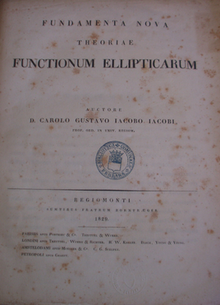
Johann Carl Friedrich Gauss was a German mathematician, astronomer, geodesist, and physicist who made contributions to many fields in mathematics and science. Gauss ranks among history's most influential mathematicians and has been referred to as the "Prince of Mathematicians". He was director of the Göttingen Observatory and professor at the university for nearly half a century, from 1807 until his death in 1855.
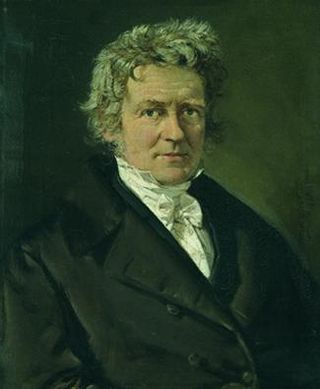
Friedrich Wilhelm Bessel was a German astronomer, mathematician, physicist, and geodesist. He was the first astronomer who determined reliable values for the distance from the sun to another star by the method of parallax. Certain important mathematical functions were named Bessel functions after Bessel's death, though they had originally been discovered by Daniel Bernoulli before being generalised by Bessel.
In the mathematical field of complex analysis, elliptic functions are special kinds of meromorphic functions, that satisfy two periodicity conditions. They are named elliptic functions because they come from elliptic integrals. Those integrals are in turn named elliptic because they first were encountered for the calculation of the arc length of an ellipse.

Carl Gustav Jacob Jacobi was a German mathematician who made fundamental contributions to elliptic functions, dynamics, differential equations, determinants, and number theory. His name is sometimes given as Karl Gustav Jakob.

Johann Peter Gustav Lejeune Dirichlet was a German mathematician who made contributions to number theory, and to the theory of Fourier series and other topics in mathematical analysis; he is credited with being one of the first mathematicians to give the modern formal definition of a function.
In mathematics, the Jacobi elliptic functions are a set of basic elliptic functions. They are found in the description of the motion of a pendulum, as well as in the design of electronic elliptic filters. While trigonometric functions are defined with reference to a circle, the Jacobi elliptic functions are a generalization which refer to other conic sections, the ellipse in particular. The relation to trigonometric functions is contained in the notation, for example, by the matching notation for . The Jacobi elliptic functions are used more often in practical problems than the Weierstrass elliptic functions as they do not require notions of complex analysis to be defined and/or understood. They were introduced by Carl Gustav Jakob Jacobi. Carl Friedrich Gauss had already studied special Jacobi elliptic functions in 1797, the lemniscate elliptic functions in particular, but his work was published much later.
In mathematics, monstrous moonshine, or moonshine theory, is the unexpected connection between the monster group M and modular functions, in particular, the j function. The initial numerical observation was made by John McKay in 1978, and the phrase was coined by John Conway and Simon P. Norton in 1979.
In mathematics, the Jacobi triple product is the mathematical identity:

Leo Königsberger was a German mathematician, and historian of science. He is best known for his three-volume biography of Hermann von Helmholtz, which remains the standard reference on the subject.
In mathematics, a doubly periodic function is a function defined on the complex plane and having two "periods", which are complex numbers u and v that are linearly independent as vectors over the field of real numbers. That u and v are periods of a function ƒ means that
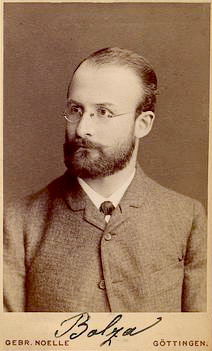
Oskar Bolza was a German mathematician, and student of Felix Klein. He was born in Bad Bergzabern, Palatinate, then a district of Bavaria, known for his research in the calculus of variations, particularly influenced by Karl Weierstrass' 1879 lectures on the subject.
In mathematics, specifically in differential geometry, isothermal coordinates on a Riemannian manifold are local coordinates where the metric is conformal to the Euclidean metric. This means that in isothermal coordinates, the Riemannian metric locally has the form
This is a timeline of the theory of abelian varieties in algebraic geometry, including elliptic curves.
In mathematics, a Jacobian, named for Carl Gustav Jacob Jacobi, may refer to:
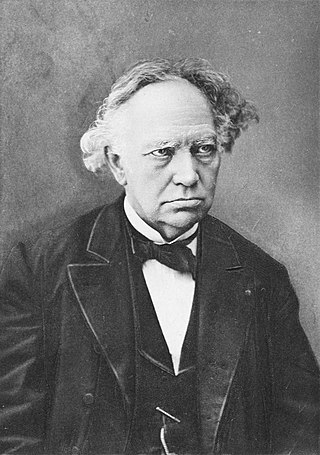
Charles Hermite FRS FRSE MIAS was a French mathematician who did research concerning number theory, quadratic forms, invariant theory, orthogonal polynomials, elliptic functions, and algebra.
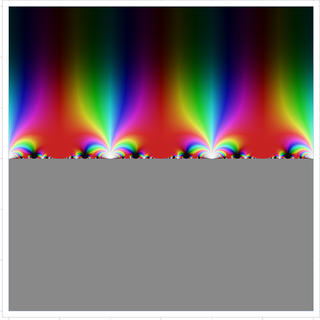
In mathematics, the modular lambda function λ(τ) is a highly symmetric Holomorphic function on the complex upper half-plane. It is invariant under the fractional linear action of the congruence group Γ(2), and generates the function field of the corresponding quotient, i.e., it is a Hauptmodul for the modular curve X(2). Over any point τ, its value can be described as a cross ratio of the branch points of a ramified double cover of the projective line by the elliptic curve , where the map is defined as the quotient by the [−1] involution.
Georg Heinrich Ferdinand Nesselmann was a German orientalist, a philologist with interests in Baltic languages, and a mathematics historian.

Heinrich Eduard Schröter was a German mathematician, who studied geometry in the tradition of Jakob Steiner.
The Canon arithmeticus is a set of mathematical tables of indices and powers with respect to primitive roots for prime powers less than 1000, originally published by Carl Gustav Jacob Jacobi. The tables were at one time used for arithmetical calculations modulo prime powers, though like many mathematical tables they have now been replaced by digital computers. Jacobi also reproduced Burkhardt's table of the periods of decimal fractions of 1/p, and Ostrogradsky's tables of primitive roots of primes less than 200, and gave tables of indices of some odd numbers modulo powers of 2 with respect to the base 3.
In mathematics Abel elliptic functions are a special kind of elliptic functions, that were established by the Norwegian mathematician Niels Henrik Abel. He published his paper "Recherches sur les Fonctions elliptiques" in Crelle's Journal in 1827. It was the first work on elliptic functions that was actually published. Abel's work on elliptic functions also influenced Jacobi's studies of elliptic functions, whose 1829 published book "Fundamenta nova theoriae functionum ellipticarum" became the standard work on elliptic functions.
